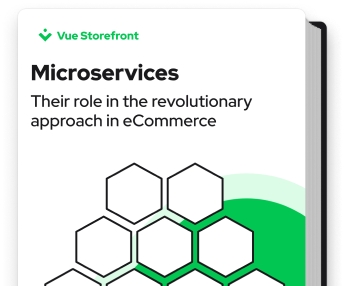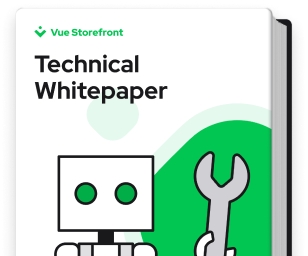Explore by Category:
Microservices
How to Choose Best Microservice Frameworks for eCommerce Business
Deciding on the framework is the first thing you need to do when starting your microservice architecture journey. Microservices frameworks will determine your project’s success, development expense, scalability, and performance.
In this article you’ll get an overview of the best microservices frameworks. Discover what microservices frameworks are and how to choose the one that suits your business the most.
What is a microservice framework?
A microservice framework is used to build a microservice architecture . The framework itself reduces the amount of code you have to write, for example, while creating a web application exclusively in JavaScript code.
Microservice architecture implies that individual apps comprising an eCommerce tech stack are separately developed, deployed, and managed. A specific microservice is created to play a particular role, like, for example, delivering product search reviews, checkout, wish lists, etc.
A decentralized development process allows you to experiment with different solutions and implement new functionalities for customers before your competitors do.
How microservices can help the eCommerce businesses
Online shopping continues to evolve, and the future is expected to bring the adoption of tech shifts that accelerate tech deployments, online marketing activities, and scaling. With the burdens monolith eCommerce applications cause, microservices open up an easy way towards the digital transformation.
Benefits of microservices for IT teams in eCommerce
Microservices provide many benefits to the tech infrastructure, which boosts overall organizational efficiency.
Microservices:
can be developed and deployed using different languages and tools
require less development time and a more nimble approach
scale fast
are reusable - can be reproduced in different projects
incorporate better failure isolation
are speedier and significantly less resource-consuming when it comes to deployment and load balancing
require less time spent on implementation
Benefits of microservices for Business teams in eCommerce
Although the benefits of microservices are primarily addressed to IT teams, the business side of eCommerce also gets a solid operational boost.
- Changes to the frontend can be introduced quickly and without developer help. Once the development is freed from a rigid technology stack of a monolith and its dependencies, marketing teams can iterate at scale. Each business function of a monolith can be replaced with a dedicated microservice. By providing a custom pattern once, marketing teams gain a higher level of independence in activities oriented towards customer experience.
- Easy scaling. Microservices architecture enables easy and fast scaling. Each service has its own life cycle – it’s created, modified, tested independently and can be removed if needed without disrupting the whole system. With that flexibility, growth-oriented eCommerce can plan investments gradually.
- Daily operations that are more resilient. Malfunctions in a single microservice don’t affect the entire system and can be handled by a dedicated team, which is non-dependent on dev teams working on other parts of the eCommerce stack.
- Cost optimization. The entire infrastructure can be highly optimized for costs as microservices are cloud-native. Thus each one can be hosted on a different cloud instance based on its bandwidth requirements.
Why do microservices matter in eCommerce?
The architecture of microservices secures eCommerce so it can respond quickly to market trends and customer expectations. Decoupled, the microservices-oriented architecture enables:
Fast implementation of various new touchpoints to the frontend
Implementation of headless systems that provide multiple frontends to work on one backend system
Separation of the frontend from the backend; therefore, the frontend traffic does not affect the backend
An open path to compose eCommerce software with 3rd party applications
Rapid performance
The best technology stack implementation, which gives merchants the freedom to pick the functionalities and features essential for business

Microservices with their architecture enable eCommerce to scale fast and compose their tech stack with modern solutions.
Loosely coupled architecture reduces the dependency of marketing and IT teams. Daily operations, thanks to well-tailored dedicated services, happen faster. Any changes or extensions don't take months. At the same time, the eCommerce team doesn't risk putting the entire system down with a minor update.
Main types of microservices frameworks
Node.js microservice frameworks
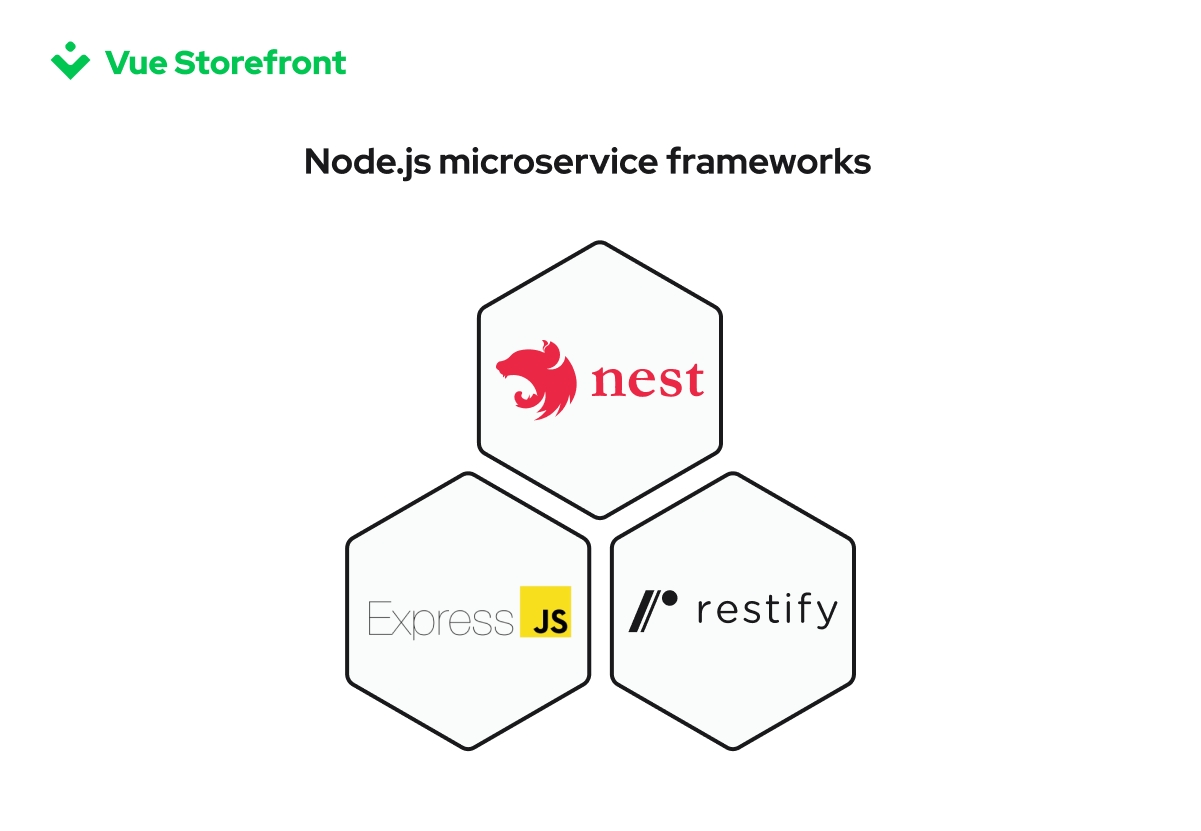
Node.js is an open-source JavaScript runtime engine for creating desktop and server apps. Let's take a look at the most popular Node.js microservices frameworks.
Nest.js
Nest.js is an open-source Node.js framework used to create backend systems. Right now, this is the fastest-growing Node.js framework out there. With Nest.js, you can build easy, scalable, efficient, and loosely coupled apps. Also, this framework supports databases like PostgreSQL, MongoDB, and MySQL.
Nest.js was built on top of the earlier mentioned Express.JS. But, it offers multiple functionalities and out-of-the-box APIs. Just as with Express.JS, Nest.js lets developers build applications with less code.
Nest.js supports numerous Nest-specific modules for integrating with standard technologies like TypeORM, Mongoose, GraphQL, Logging, Validation, Caching, WebSockets, etc. Another significant aspect of Nest.js is that it provides its users with detailed and well-maintained documentation.
Alokai uses Nest.js for building microservice applications. Want to build Nest.js microservices? Read the article on how to build Microservices with Nest.js.
Features of NestJS
- TypeScript. This framework uses Typescript, which is a strongly typed language that is superior to JavaScript.
- Command Line Interface (CLI). NestJS has a robust CLI for boosting productivity and making the development process more manageable.
- Dependency Injection (DI) container. The framework includes a built-in DI container for building modular applications.
- Lazy Loading. This module is used for loading things when necessary, which helps the applications to run smoother.
ExpressJS
Express.JS is an open-source Node.js microservice application framework that delivers a comprehensive set of features for making web and mobile applications. The framework is a fast, lightweight Node.js development tool with abilities to build high-quality APIs for mobile and online apps.
Also, Express.JS serves as a layer created on top of the Node js for managing servers and routes. This framework provides developers with pre-written code and is used for building single pages, multipage, and even hybrid web applications.
Features of Express JS
- Fast Server-Side Development. Express.JS is equipped with Node.js features in the form of functions that developers can use anywhere in the program. This means the coding process is faster and easier.
- Middleware. Middleware is a program component that accesses a database, client requests, and other middleware. This feature is accountable for the systematic organization of various functions of Express.JS.
- Routing. Express.JS has a progressive routing mechanism for preserving a webpage's state with its URLs.
- Templating. Express.JS has templating engines for building dynamic content on web pages by making HTML templates on the server side.
- Debugging. This feature is essential for developing a successful product. Express.JS can identify the specific part of the web application where bugs are.
Restify
Restify is a Node.js microservice framework optimized for creating semantically valid RESTful web services prepared for scaling. This framework is mainly used for optimizing performance. Also, Restify provides developers with bi-directional communication to web and client-side components.
Features of Restify
- DTrace support. Restify automatically makes DTrace probes for developers when they add a new route/handler.
- Semantics correction. Following the spec is one of the most important goals of the Restify framework. It provides you references to RFCs placed throughout GitHub issues and the codebase.
- Error management. With Restify, you can address errors instantly and systematically. This framework provides numerous error-trapping processes for finding errors and bugs.
TypeScript microservice frameworks
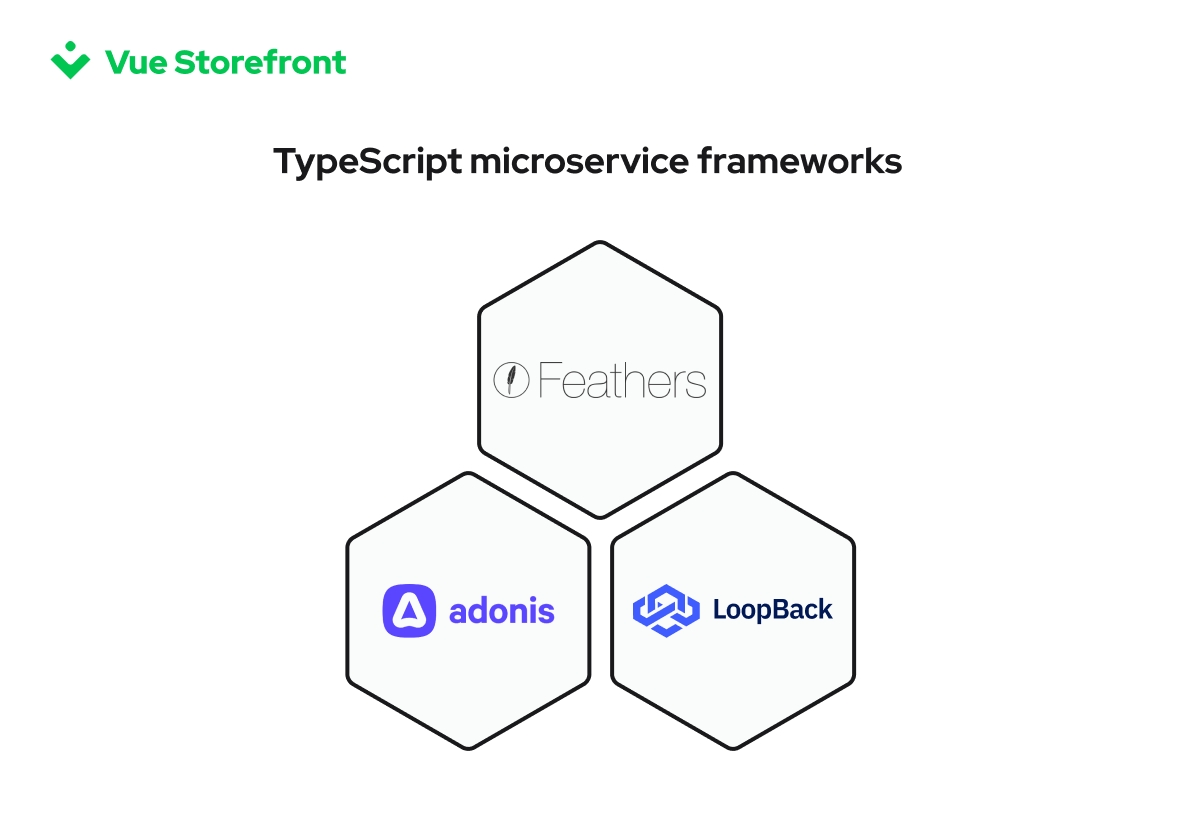
Let's take a look at the most popular TypeScript microservices frameworks.
Feathers
Feathers is a lightweight microservice web framework for building real-time applications and REST APIs using JavaScript or TypeScript.
This framework can interact with any backend technology, supports numerous databases, and operates with almost every frontend technology (React, VueJS, Angular, React Native, Android, or iOS).
Features of Feathers
- Relational and Non-Relational Databases. FeathersJS lets developers interact with different relational and non-relational databases. The framework makes it effortless for developers to connect to various databases, query databases through a single interface, and exchange databases.
- Accelerates Error Handling. Feathers framework can automatically return It also reports errors to the client in a readable format.
- Authentication. FeathersJS supports authentication. Developers can secure applications by executing email/password, token, and OAuth authentication. They can also add authentication features via special plugins.
- Extension and Customization. Developers can easily integrate FeathersJS with web frameworks like AngularJS, React, React Native, and VueJS. Also, they can extend and customize the framework by integrating plugins.
LoopbackJS
Loopback.js is a Node.js and TypeScript framework for building APIs and microservices. This framework can make REST APIs from minimal to no code. Loopback.js delivers Full Stack programming capacity. It contains pre-installed modules and features.
LoopbackJS features
- Nested data. Loopback.js uses schemas to create GraphQL data definitions and links defined in the OAS to create a nested structure, authorizing (deeply) nested queries.
- Built-in models. All LoopBack applications have a set of predefined built-in models like User, Role, and Application. This means developers don’t have to make these standard models from scratch.
- Routing. LoopBack is created on Express and uses Express’ routing system. But, Express routing is restricted only to a small part of the functionality of LoopBack. LoopBack uses a more detailed extension to the routing system.
- Middleware phases. LoopBack middleware is similar to Express middleware but LoopBack adds the concept of phases to define the order in which middleware is called. This approach allows developers to avoid ordering issues with traditional Express middleware.
AdonisJS
AdonisJs is a framework for Node.js which uses TypeScript to create microservice applications. It is one of the most well-known frameworks that works on all primary operating systems. This framework has a simple query builder that lets you quickly build straightforward queries.
Features of AdonisJs
- Folder structure. This framework provides users with a convenient folder structure to help them stay organized.
- Validator. AdonisJs has a dedicated validation provider feature for easy user input validation.
- Security. AdonisJs has powerful tools for protecting websites from standard web attacks.
- Testing. The framework considers the cumbersomeness of manual testing and lets developers create functional unit tests to check their web applications.
JavaScript microservice frameworks
Let's take a look at the most popular JavaScript microservices frameworks.
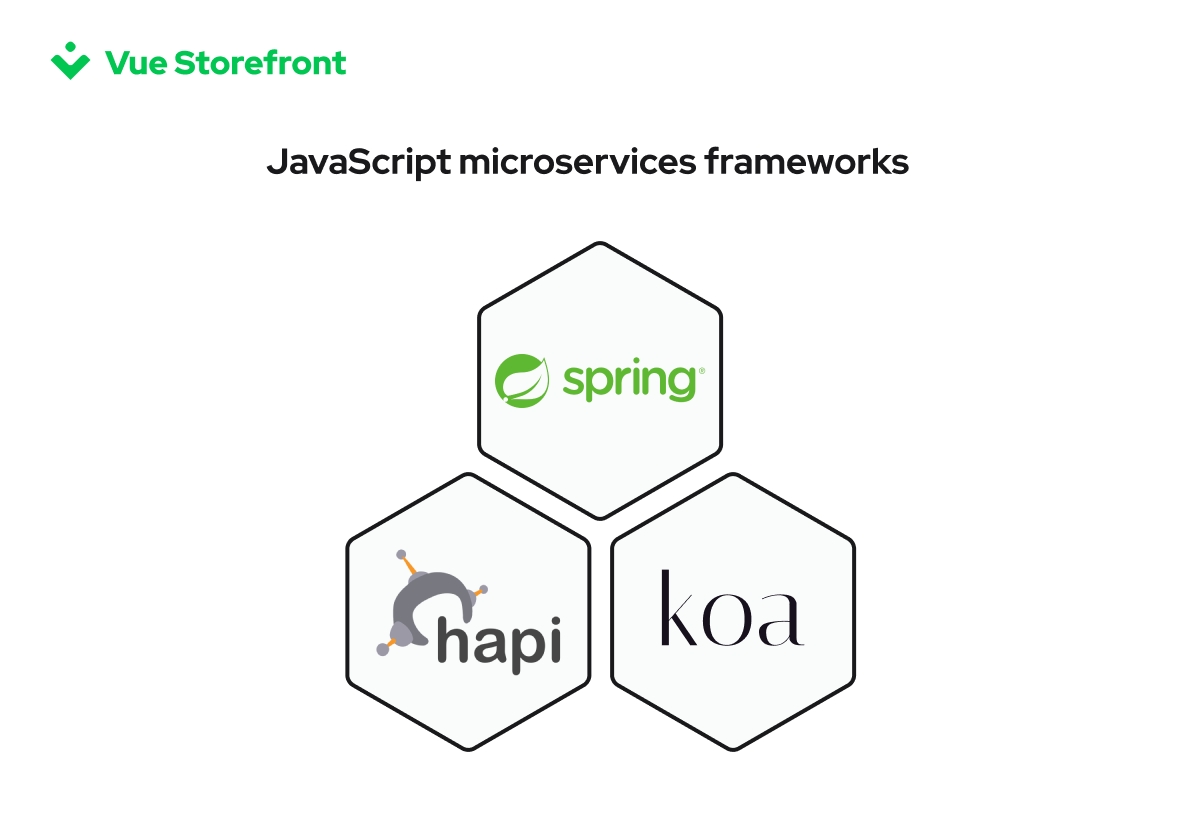
Spring Boot
Spring Boot is a well-known framework for microservices application development. It provides developers with numerous add-on modules on Spring Cloud for creating microservices architecture. Spring Boot is great for building both small and large-scale systems. This framework uses Reversal of Control to combine with other frameworks easily.
Features of Spring Boot
- Lazy Initialization. When this feature is enabled, beans are created as required rather than during application startup. This leads to a reduction in the time it takes for the application to start.
- Startup Failure. This feature notifies you of an error message and a concrete action to fix the problem when your application fails to start.
- Application Availability. When an application is deployed on a platform, it can supply details about its availability. For example, Spring Boot has out-of-the-box support for the typically used “liveness” and “readiness” availability states.
Hapi
Hapi is an open-source framework for microservices applications. It is another framework created with a similar architecture to Express.js for writing less code.
Developers like to use it because of its trustworthy security features. It is an excellent option for creating proxy servers, REST APIs, and other desktop applications. Also, Hapi has numerous built-in plugins, so developers don’t need unofficial middleware.
Features of Hapi
- Authentication and Authorization. Hapi provides built-in authentication and authorization methods. For example, there are anonymous, basic-auth, cookie-based, and token-based authentication methods.
- Caching. This framework makes operating with cache very convenient with its strong client and server-side caching.
- Cookies. Hapi makes working with cookies adjustable, secure, and straightforward. For that, it provides different configuration possibilities.
- Simplified Error Handling. Boom is a part of the Hapi ecosystem that provides utilities for returning HTTP-friendly error objects.
- Process Monitoring. Hapi has a plugin for monitoring and reporting different Hapi server events.
Koa.js
Koa’s core doesn’t have any middleware, but it does include an elegant collection of methods for writing servers quickly and easily. It is a new open-source web framework built by the creators of Express.js. This framework is a smaller, pricier, and more robust foundation for web applications and APIs. Koa uses async functions to ditch callbacks and improves error handling. It has no middleware and provides a comprehensive suite of methods that make creating servers a quick and pleasant task.
Features of Koa.js
- ES6 generators. Koa.js uses ES6 generators to simplify synchronous programming and enables both the upstream and downstream flow of controls.
- Error handling. The framework has built-in error protection that helps developers avoid website crashes. Developers can report bugs with a simple try/catch command without writing additional code. There is also an option for customizing error handling by changing the default setting.
- Context object. Koa.js uses Context to encapsulate the response and request objects into a single object. The Unified Object makes it effortless for developers to create web applications and APIs, including several helpful evaluation methods and tools.
How to choose the best microservice frameworks

Choosing a microservice framework that works for your project is quite an important task. As you can see, the world of microservice frameworks is extremely saturated. Below you will find a list of criteria worth considering when deciding on a microservice framework.
Ease of development
Frameworks are supposed to improve developer productivity and make microservice application development more accessible. Pay attention to the framework features and the Integrated Development Environment (IDE), as they play a crucial part in the fast development of applications. An integrated development environment (IDE) is an application that enables the development of other applications. IDE is created to enclose all programming tasks in one application.
A mixture of frameworks and languages
Based on the project's requirements, you might need microservice frameworks that support different languages and can be integrated with other frameworks. For example, TypeScript, Node.js, and JavaScript are favored languages for creating microservices.
Architectural support
Microservices frameworks should include code modules as well as interfaces with built-in design patterns. This approach dismisses the coding complexity and makes the process clear and simple.
Strong community
Numerous developers work with a microservices architecture. By checking the community of the microservice framework, you might get an overview of its reputation, downsides, and benefits. Also, you can evaluate the framework's support and update release frequency.
Automation support
You can benefit from a microservice framework that includes automation support. It not only makes deployment and implementation of microservices easier for your developers, but it also quickens the development process.
If you want to find out more about microservices, you can read our article: Microservices examples: Popular patterns and real-life eCommerce success stories
The bottom line
Microservices with their architecture enable eCommerce to scale fast and compose with modern solutions. Loosely coupled systems change the online sales game, providing higher performance and easing daily operations. By upgrading the commerce stack merchants secure an omnichannel experience.
Choosing the right microservices framework to quickly and cost-effectively create top-notch applications is challenging. This article equipped you with the most crucial information that can come in handy.
Base your choice of a microservice framework on your project requirements and ease of development process, language options, architectural support, community review, and the availability of automation support.
Share:
Share:
More in Microservices
Frequently asked questions
Ready to dive in? Schedule a demo
Get a live, personalised demo with one of our awesome product specialists.



















